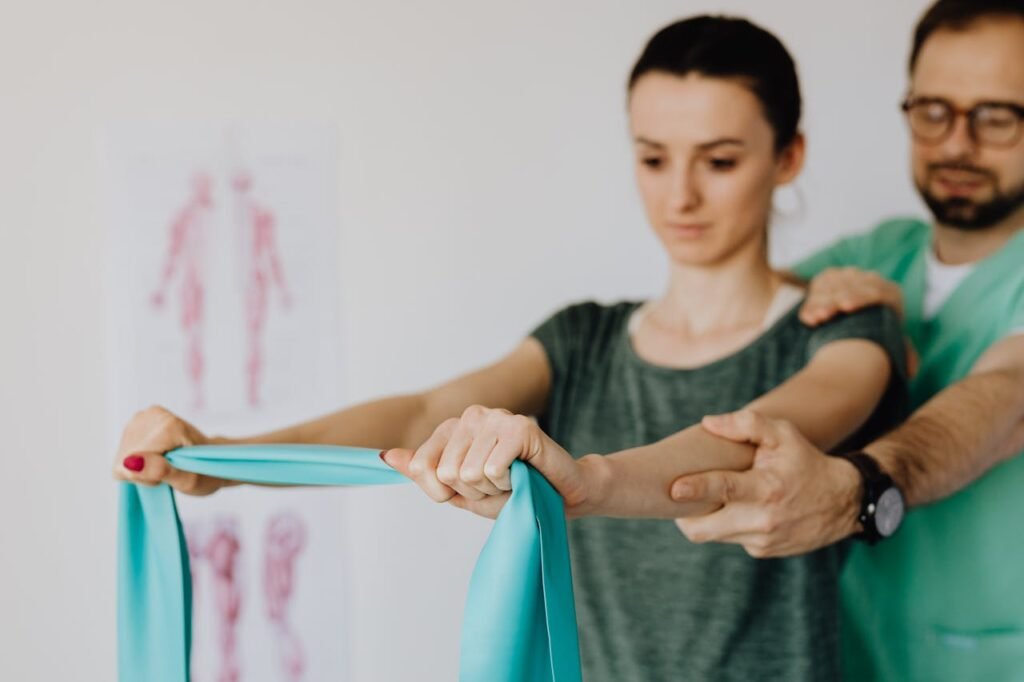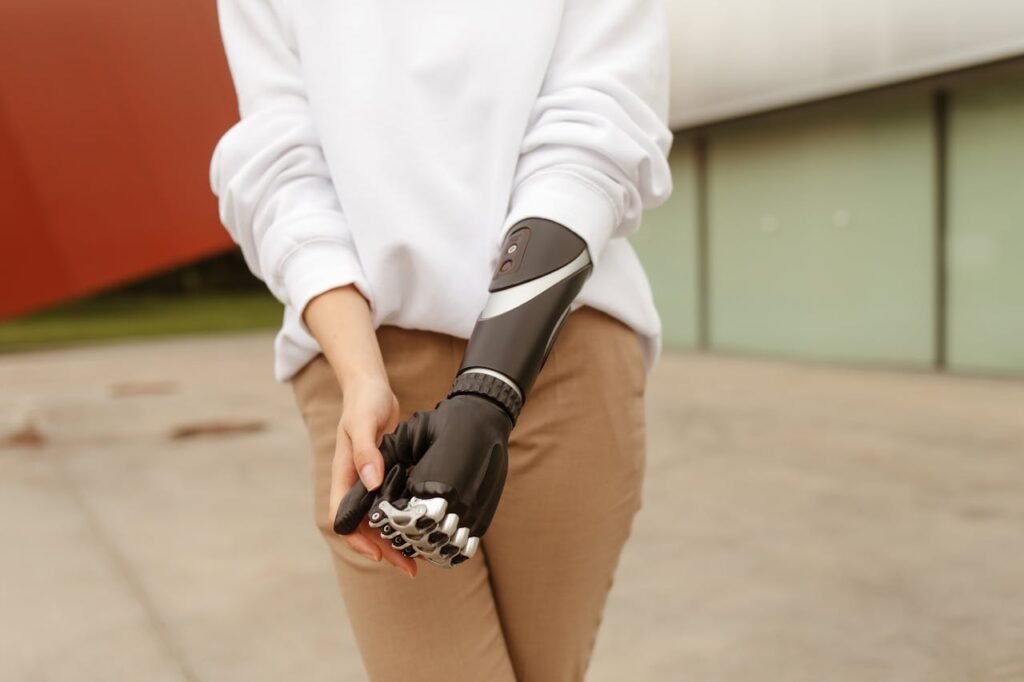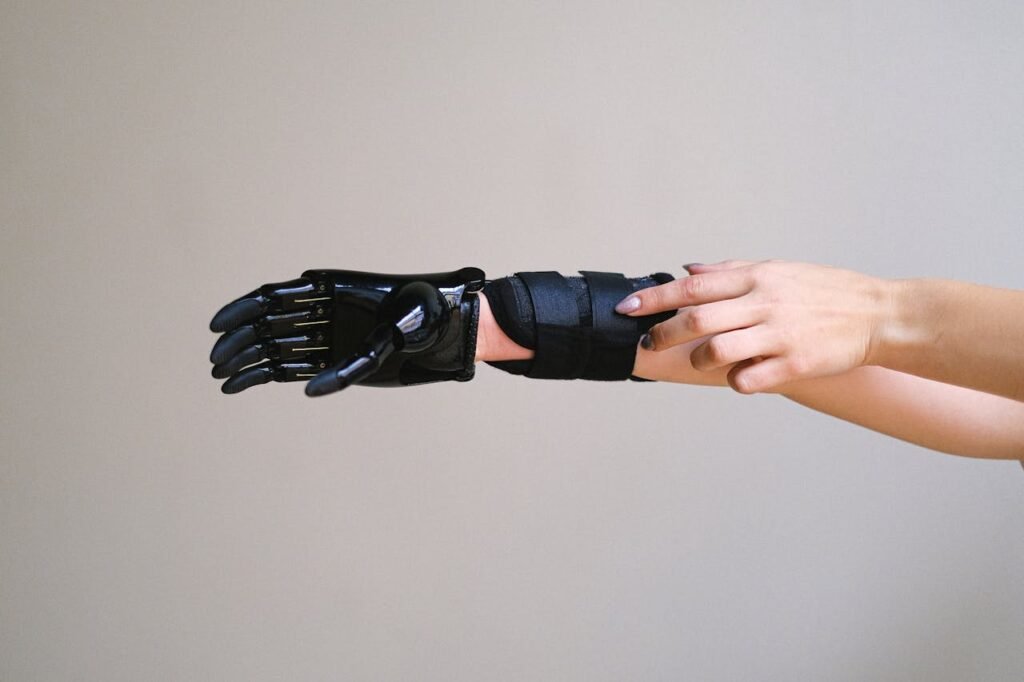After an amputation, many things change. Movement slows down. Muscles weaken. Pain and stiffness often settle in. People may feel stuck, waiting for their body to heal, unsure of what comes next.
But there’s one tool that’s quietly making a difference—Electrical Muscle Stimulation, or EMS.
EMS sends gentle electrical signals to your muscles, helping them move and grow stronger—even when you can’t move them much yourself. It keeps the body active. It keeps recovery going.
And for people living with limb loss, it’s becoming a powerful way to build strength, speed up healing, and get ready for prosthetics.
In this article, we’ll explore how EMS works, why it matters, and how it helps strengthen the muscles that remain after an amputation—one gentle pulse at a time.
What Happens to Muscles After Amputation
Muscles Start to Shrink When They’re Not Used

When a person loses a limb, the muscles around the area begin to change quickly.
Because they’re no longer being used in the same way, these muscles start to shrink—a process called muscle atrophy.
This can begin within just a few days of reduced movement.
Even the muscles that are still intact can weaken. They’re no longer part of the full motion they once helped create. As a result, they lose their strength and flexibility.
If this continues for weeks or months, the muscle becomes harder to wake up again.
It loses tone. It becomes stiff. And it doesn’t respond as quickly when asked to move later—especially when using a prosthetic.
Stiffness and Weakness Affect Recovery
Without regular movement, joints also begin to stiffen.
Muscles tighten up. Blood doesn’t flow as well. The person may feel discomfort, pain, or even spasms.
This can lead to limited motion. It makes it harder to do basic things like stretch, reach, or walk.
It also affects how a prosthetic fits. When muscles are weak or underused, the shape of the limb can change. This leads to socket discomfort, poor control, and slow adaptation.
That’s why keeping the residual muscles active is key—right from the start.
Emotional Impact of Muscle Loss
There’s also an emotional side to muscle loss.
When the limb changes shape, or when the person sees their body getting weaker, it can be discouraging. It makes the recovery journey feel longer, harder, and more frustrating.
Many people start to feel disconnected from the remaining part of their limb. They may stop trying to move it altogether.
This emotional distance can slow healing even more.
But EMS can step in here—to not only bring the muscles back to life but also help the person reconnect with their body and feel in control again.
How EMS Supports Residual Muscle Strength
What Is EMS and How Does It Work?

EMS stands for Electrical Muscle Stimulation.
It works by sending small, safe electrical pulses through the skin to your muscles. These pulses cause the muscle to contract—just like it would during natural movement.
The difference is that with EMS, the brain doesn’t have to do the work.
Even if a person is tired, in pain, or unable to move the limb themselves, EMS activates the muscle gently.
It creates a small “workout” for the muscle—without requiring effort from the user.
This helps prevent atrophy. It improves blood flow. And over time, it strengthens the muscle fibers and makes them more responsive.
Stimulating the Right Muscles After Amputation
After an amputation, some muscles are still there, even if the limb is not.
For example, someone with a below-elbow amputation still has muscles in the upper forearm and arm. These are the same muscles that controlled the hand and fingers before.
EMS can target these residual muscles. It stimulates them to move—even without the rest of the limb.
This keeps the brain-body connection alive. It helps the brain remember how those muscles used to work, and it trains the body to activate them again.
Later, when a prosthetic is added, these muscles are already “awake.” They can send signals more clearly. They’re stronger, more flexible, and ready to help.
Supporting Balance and Joint Health
EMS also helps muscles that support posture and balance—especially for lower limb amputees.
By stimulating muscles in the hips, thighs, or calves, EMS supports better alignment. It keeps the person standing more evenly. It reduces strain on the spine and opposite leg.
This means less back pain, better walking patterns, and smoother movement overall.
And because EMS improves circulation, it helps reduce swelling and keeps joints from stiffening.
This makes prosthetic training easier. It reduces the risk of long-term complications like arthritis or poor gait mechanics.
When and How to Start EMS After Amputation
The Best Time to Begin EMS

Timing matters when it comes to recovery.
Many people assume that therapy can only begin once wounds are fully healed or once a prosthetic has been fitted. But with EMS, you don’t have to wait that long.
EMS can often be started just a few days or weeks after surgery, once the swelling has gone down and the wound is stable.
The earlier you start, the better the results.
Starting EMS early helps prevent muscle loss before it sets in. It keeps blood flowing, which helps the body heal faster. It also gives the person a sense of progress at a time when they might otherwise feel stuck.
Of course, every case is different. A doctor or physiotherapist should always confirm the right time to begin.
But in most cases, EMS is a safe, gentle way to support recovery early on.
How Often Should EMS Be Used?
Like any therapy, consistency is key.
For the best results, EMS should be used daily or several times a week. Each session can last between 15 to 30 minutes, depending on the goal.
In the early days, shorter sessions may be better to avoid fatigue. As the muscles get stronger, the duration and intensity can be increased.
Most users begin to feel benefits within a few sessions—such as less tightness, more movement, and better comfort.
Over time, regular EMS use builds long-term strength. It helps the muscles support the body better and improves the readiness for prosthetic use.
Safety Guidelines for EMS Use
EMS is generally safe, but like any treatment, it must be used carefully.
Pads should be placed only on healthy skin—not over wounds or areas with swelling. The device should be clean, charged, and in good working condition.
Stimulation should feel like a light pulse—not painful or sharp. If it’s uncomfortable, the intensity is likely too high and should be turned down.
Users with pacemakers, certain heart conditions, or nerve damage should consult a doctor before using EMS.
At Robobionics, our BrawnBand EMS system comes with safety instructions, video guides, and user-friendly settings—so even first-time users can feel confident.
We also train caregivers, family members, and rehab professionals on proper usage, to make sure every session is both safe and effective.
EMS and Daily Life
One of the great things about EMS is how easy it is to fit into daily life.
You can use it while sitting in a chair, lying in bed, or even while reading or watching TV. It doesn’t require special equipment or clinic visits.
This means users can take control of their own recovery, right from home.
For many, this becomes a routine part of their day—like brushing their teeth or doing a stretch. It gives them a clear, simple task to focus on. And over time, it leads to stronger muscles, better movement, and higher confidence.
It’s a small habit with big impact.
How EMS Prepares Muscles for Prosthetics and Myoelectric Control
Rebuilding Strength for Real-World Movement
When someone receives a prosthetic—whether it’s a simple mechanical design or a smart myoelectric one—their success depends heavily on the condition of the muscles they still have.
Muscles are not just about strength. They help shape the way a prosthetic fits. They create the signals that advanced bionic limbs read and respond to. If these muscles are weak, poorly trained, or inactive for too long, even the best prosthetic won’t work the way it should.
This is where EMS plays a deeply supportive role.
By applying gentle electrical stimulation directly to the muscles in the residual limb, EMS keeps these muscles active. Even if the person can’t fully move the arm or leg, the device encourages muscle contractions. Over time, these repeated contractions help restore tone, improve blood circulation, and keep the tissue firm and ready for load-bearing or movement.
The result is a limb that’s better prepared to receive and support a prosthetic—especially when it comes to the precise movements needed for more advanced control.
Preparing for Myoelectric Signal Clarity
Myoelectric prosthetics, like the Grippy Bionic Hand developed by Robobionics, are designed to respond to electrical signals that naturally occur in muscles when the user tries to move. These signals, called EMG (electromyographic) signals, are picked up by sensors in the prosthetic.
But these signals need to be strong, clean, and easy to read. If the muscle is too weak, too stiff, or underused, the signals can become faint or confusing. The prosthetic might respond slowly, move unpredictably, or fail to move at all.
EMS helps solve this problem.
Regular stimulation trains the muscle to contract with more force and better control. This doesn’t just improve strength—it sharpens the signal. EMS encourages the nervous system to stay connected to the muscle. Over time, the brain relearns how to send targeted signals to specific muscle groups.
This is especially important for users who are learning to isolate small movements, like gripping or pinching. EMS builds the foundation for that control long before the prosthetic is even fitted. So when it’s time to use the device, the user already has the muscle memory and responsiveness needed to make the most of it.
Creating a Smoother Transition to Prosthetic Use
For many people, the first few days or weeks with a prosthetic are filled with adjustment. The socket may feel unfamiliar. The limb may feel sore. The controls may seem hard to manage at first.
But when EMS has been part of the recovery journey, this transition becomes easier.
The limb is already used to movement. The muscles have not become completely inactive. The body doesn’t treat the prosthetic as something entirely new—it simply becomes the next step in an ongoing process of motion and function.
Users often report less discomfort during fitting. They learn to control their new limb faster. They feel more confident because their body is stronger, more stable, and better prepared.
And in cases where prosthetics are delayed—due to costs, travel, or healing needs—EMS ensures that the body doesn’t lose time. The person can keep building strength even while they wait, so no recovery momentum is lost.
A Key Part of the Prosthetic Fitting Process
Some prosthetic technicians now include EMS as part of their pre-fitting program.
They use it to help shape the residual limb, firm up the muscles, and train the user to activate specific muscle groups. This allows for more accurate socket fitting, better sensor placement, and more reliable control once the device is worn.
In fact, EMS is especially helpful for targeted muscle reinnervation (TMR) cases, where nerves are surgically redirected to new muscles. These re-routed muscles must be trained carefully, and EMS helps stimulate them safely in the early stages.
At Robobionics, we often encourage users who are preparing for a Grippy Bionic Hand or Grippy Mech Hand to start EMS with our BrawnBand system before the prosthetic arrives. This allows them to be physically ready, emotionally confident, and functionally stable from the moment they begin using their device.
Adapting EMS to Different Levels of Amputation and Individual Needs
No Two Amputations Are the Same

Every person’s body is different. Every amputation comes with its own challenges.
The level at which the limb was lost, the strength of remaining muscles, the condition of the skin, and even the person’s daily routine all affect recovery. That’s why no single rehab method works for everyone—not even EMS.
But what makes EMS special is its ability to adapt.
Whether someone has lost part of a finger, an entire arm, or a leg, EMS can be adjusted to match their specific needs. From the placement of the electrodes to the intensity of the stimulation, everything can be personalized.
This flexibility allows EMS to serve a wide range of people—not just in hospitals, but in homes, clinics, and rehab centers across India.
For Below-Elbow Amputees: Rebuilding Forearm Control
In people who have lost their hand or part of the arm below the elbow, EMS is often used to stimulate the forearm muscles. These muscles are still functional. They once controlled the hand and fingers, and they continue to play a role in prosthetic control.
By stimulating the flexors and extensors in the forearm, EMS keeps those muscles strong and engaged. This is crucial not only for strength but for accurate, clean control in myoelectric hands like the Grippy Bionic Hand.
When done regularly, this stimulation improves grip precision, reduces the risk of joint stiffness, and ensures a better fit for prosthetic sockets that wrap around the forearm.
For Above-Elbow Amputees: Supporting Shoulder and Upper Arm Stability
In above-elbow amputations, the loss is more extensive. The challenge becomes maintaining upper arm and shoulder strength, which is necessary for posture, lifting, and movement coordination.
EMS in these cases focuses on the biceps, triceps, and deltoid muscles. These muscles don’t just move the prosthetic—they support the entire arm and prevent issues like muscle imbalance or postural collapse.
Stimulation in this area improves shoulder function, reduces back strain, and allows for smoother movement when the prosthetic is attached.
Additionally, for people using body-powered prosthetics, EMS helps build endurance in the muscles used for cable-driven control.
For Lower-Limb Amputees: Preparing for Weight-Bearing and Walking
For people who have lost a leg—whether below or above the knee—EMS plays a crucial role in helping them stand, balance, and walk again.
After a lower-limb amputation, muscles in the thigh, hip, and lower back must compensate for the lost joint. Without proper support, the person may limp, tilt, or overuse the remaining leg.
EMS helps by stimulating the quadriceps, hamstrings, and gluteal muscles. This improves core stability and makes it easier to bear weight on the prosthetic leg. It also prevents the development of a crooked or inefficient walking pattern.
In above-knee amputees, EMS becomes even more important. The hip must take on the job of both the knee and the ankle. Regular stimulation strengthens these larger muscles, allowing for smoother transitions during walking, climbing stairs, or rising from a chair.
For many users, EMS also helps reduce stump pain and swelling—common issues that delay prosthetic use.
For Partial Finger or Hand Amputations: Restoring Fine Motor Skill
Finger loss might sound small compared to an arm or leg, but its impact is deeply felt—especially when it comes to grip, dexterity, and balance.
For those who have lost one or more fingers, EMS helps train the remaining hand muscles to pick up the slack.
Even partial finger movement involves complex coordination between small muscles in the palm and forearm. EMS applied here must be low in intensity but high in precision. It stimulates individual groups like the thenar (thumb) or hypothenar (little finger) muscles, depending on the amputation pattern.
This is particularly useful for people preparing to use devices like the Grippy Mech Finger, which supports partial hand restoration through smart mechanical grip.
With EMS, users regain not only strength but control over how the hand interacts with objects—whether it’s a pen, a spoon, or a phone.
For Bilateral Amputees: Rebuilding Strength and Confidence
People with amputations on both sides—whether two hands, two legs, or one of each—face a greater challenge, not only physically but emotionally.
Movement becomes more difficult. Everyday tasks take more time. Confidence may drop.
But EMS can offer hope and structure.
By using stimulation on both limbs—even in alternating sessions—users can maintain balanced strength across the body. They can build endurance for tasks that require more time. And perhaps most importantly, they feel like they are participating in their own recovery, not just waiting for help.
At Robobionics, we often work with bilateral amputees who begin EMS while waiting for their first set of prosthetics. The results are encouraging: faster muscle adaptation, better posture, and greater emotional resilience.
Conclusion: Stronger Muscles, Stronger Lives

Losing a limb is never just a physical experience—it’s emotional, personal, and often deeply overwhelming. But what follows can be just as powerful: a return to movement, strength, and control.
Electrical Muscle Stimulation, or EMS, is not a miracle cure. But it is a quiet revolution.
It supports the body when it’s too weak to move. It keeps muscles alive when they risk fading. It helps the brain reconnect with the body. It gives users back something that is so often taken after amputation—momentum.
When used early, gently, and consistently, EMS can change everything.
It can shape the body for better prosthetic use. It can shorten recovery time. It can reduce pain. And most of all, it helps people feel in charge of their own healing again.
At Robobionics, we’ve seen what happens when technology meets empathy. Our BrawnBand EMS system was created for real people with real challenges. It’s easy to use, built for India, and made to move recovery forward—at home, in clinics, and across communities.
We believe that every muscle deserves a second chance. Every limb deserves support. And every person deserves to heal with dignity.
Take the Next Step
If you or someone you love is recovering from limb loss, don’t wait for strength to return on its own. Start building it—today.
Explore how the BrawnBand can become part of your recovery journey. Schedule a free consultation with our team at
www.robobionics.in/bookdemo
You’ve come this far. Let us help you go further—with every pulse, every step, and every signal of progress.
Because your story is not over. It’s just beginning—with strength, support, and hope.


